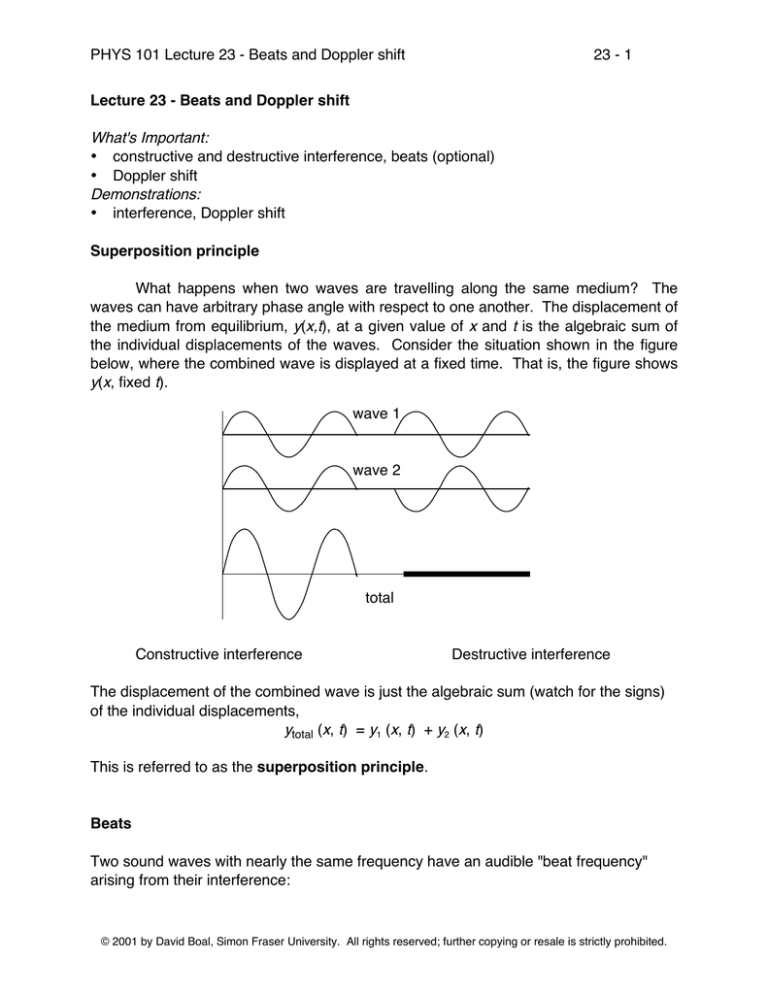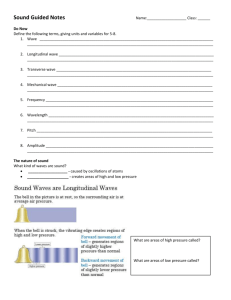PHYS 101 Lecture 23 - Beats and Doppler shift 23
advertisement

PHYS 101 Lecture 23 - Beats and Doppler shift 23 - 1 Lecture 23 - Beats and Doppler shift What's Important: • constructive and destructive interference, beats (optional) • Doppler shift Demonstrations: • interference, Doppler shift Superposition principle What happens when two waves are travelling along the same medium? The waves can have arbitrary phase angle with respect to one another. The displacement of the medium from equilibrium, y(x,t), at a given value of x and t is the algebraic sum of the individual displacements of the waves. Consider the situation shown in the figure below, where the combined wave is displayed at a fixed time. That is, the figure shows y(x, fixed t). wave 1 wave 2 total Constructive interference Destructive interference The displacement of the combined wave is just the algebraic sum (watch for the signs) of the individual displacements, ytotal (x, t) = y1 (x, t) + y2 (x, t) This is referred to as the superposition principle. Beats Two sound waves with nearly the same frequency have an audible "beat frequency" arising from their interference: © 2001 by David Boal, Simon Fraser University. All rights reserved; further copying or resale is strictly prohibited. PHYS 101 Lecture 23 - Beats and Doppler shift wave 1 23 - 2 wave 2 in phase in phase out of phase Define λ1 = wavelength of wave #1 and λ2 = wavelength of wave #2: λ2 < λ1 Suppose that the waves are in phase after n wave #1 or n+1 wave #2. The wavelength of the beat is n λ1 or (n+1) λ2. That is n λ1 = λB (1) (n+1) λ2 = λB (2) We can solve (1) for n, and substitute into (2) to obtain (λB/λ1 + 1)λ2 = λB or λB / λ1 + 1 = λB / λ2 or 1 = λB/λ2 - λB/λ1. Dividing both sides by gives 1/λB = 1/λ2 - 1/λ1. For all waves, the frequency f is related to the wavelength λ by f = c/ λ , where c is the speed of the waves (applies to beat because all waves move together). Thus, the beat frequency is just fB = f2 - f1 We assumed that λ2 < λ1, so the beat frequency is positive. Doppler effect Photoradar, and the measurement of velocities of very remote galaxies, are based upon the Doppler shift - the shift in the apparent wavelength of a wave due to the relative motion of the emitter of the wave with respect to the observer. Terrestrial example of the Doppler shift: the sound from the siren of an approaching ambulance appears to have a higher pitch (or frequency) than when the ambulance is receding. © 2001 by David Boal, Simon Fraser University. All rights reserved; further copying or resale is strictly prohibited. PHYS 101 Lecture 23 - Beats and Doppler shift 23 - 3 Consider a source of waves S which is moving with respect to an observer O. In the diagram: (a) shows the natural wavelength λ of the waves emitted by the source (b) S moves towards O and the wavelengths appear shorter as seen by O (c) the source moves away from the observer, and the waves appear longer. (a) S (b) S (c) O O ! O S We now look at (c) in more detail. first wave is emitted at t=0 S O second wave is emitted at t=T S O vT ! !' © 2001 by David Boal, Simon Fraser University. All rights reserved; further copying or resale is strictly prohibited. PHYS 101 Lecture 23 - Beats and Doppler shift 23 - 4 At time t=0, a wave is emitted by S. At time t=T (the period), another wave is emitted, but S has traveled a distance vT in time T, away from the observer. Hence, the distance between wave crests as seen by observer O is λ' = λ + vT ⇒ (λ' - λ) / λ = vT/λ But, the speed c of a wave is given by c = λ / T, so (λ' - λ) / λ = v /c or λ'/λ = 1 + v /c The shift in the wavelength from λ at the source to λ' at the observer is referred to as the Doppler shift of the wave. For sources moving towards the observer, the analysis is the same but the sign of v/c is reversed and λ' < λ. Often, one works with frequency f rather than wavelength λ, where c = fλ. Then, the Doppler expression for a stationary observer becomes f /f' = 1 + v /c or f' /f = 1 / (1 + v/c) moving away from observer Going through the same math for a source moving towards the observer: λ'/λ = 1 - v /c or f' /f = 1 / (1 - v/c) moving towards observer Example Sound waves travel at 331 m/s in air at 0 oC. What is the relative shift in frequency for a siren on an ambulance travelling away at 36 km/hr = 10 m/s? We can just use the expression for f /f' directly to obtain f /f' = 1 + v /c = 1 + 10/330 = 1.03 That is, the shift is about 3%. Example The bound electron in a hydrogen atom emits light at a set of very specific frequencies. By measuring the emission frequency from the hydrogen in a far-away star, and comparing it with the emission frequency on Earth, we can determine the speed of the star with respect to Earth. For example: frequency on Earth = f = 6.16 x 1014 s-1 frequency observed from star = 5.56 x 1014 s-1 Hence v /c = f /f' - 1 = 6.16/5.56 - 1 = 0.11. (Aside: this is the n=4 to n=2 transition in the hydrogen atom) © 2001 by David Boal, Simon Fraser University. All rights reserved; further copying or resale is strictly prohibited.






